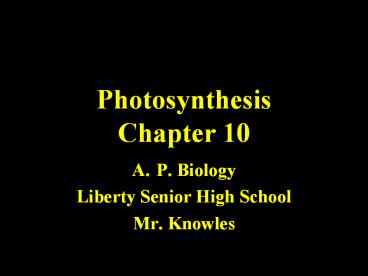Photosynthesis Chapter 10 PowerPoint PPT Presentation
1 / 38
Title: Photosynthesis Chapter 10
1
PhotosynthesisChapter 10
- P. Biology
- Liberty Senior High School
- Mr. Knowles
2
Question
- Does eating carrots really improve your vision?
3
- Photosynthesis
- Occurs in plants, algae, certain other protists,
and some prokaryotes (photoautotrophs).
4
- Plants are photoautotrophs
- They use the energy of sunlight to make organic
molecules from water and carbon dioxide
5
Chloroplasts The Sites of Photosynthesis in
Plants
- Leaves are the major sites of photosynthesis
6
- Chloroplasts
- Are the organelles in which photosynthesis
occurs contain thylakoids and grana
7
Chloroplasts
8
Photosynthesis
- lt 1.0 of suns energy that strikes Earth is
converted into 150 billion metric tons of sugar. - In cellular respiration, electrons are
transferred from sugar to oxygen they lose
potential energy to make ATP. - In photosynthesis, electrons from water gain
potential energy as they are transferred to
carbon dioxide to make sugar the energy is
provided by light.
9
C6H12O6 O2
Free Energy ? G
CO2 H2O
Rxn Time
10
Historical Perspective
- 17th Century van Helmont measured willow tree
growth compared mass of tree to mass of soil. - Late 18th Century J. Priestly restores air in
a vacuum with mint. - 18th Century Ingenhousz found air only restored
in the presence of sunlight hypothesized CO2 ? C
O2
11
Role of Water
- 1930s Van Niel studied purple sulfur bacteria
that performed photosynthesis w/o water - CO2 2 H2S Light Energy? (CH2O) H2O 2 S
- The H2S serves an electron donor.
- H2O serves as donor in green plants.
12
Role of Water
- In the 1950s used 18O ( an isotope of oxygen )
in water to trace oxygen in the reaction. - 6 CO2 12 H218O Light Energy ? C6H12O6 6
18O2 6 H2O
13
The Role of Light
- In 1900s, F. F. Blackman determined that
photosynthesis occurred in two steps. - Initial set of reactions were dependent on light-
Light Reactions or Light-Requiring Reactions. - A second set of reactions were independent of
light-Dark Reactions or Non-Light Requiring
Reactions- affected by temperature. - Dark Reactions use enzymes.
14
The Splitting of Water
- Chloroplasts split water into
- Hydrogen and oxygen, incorporating the electrons
of hydrogen into sugar molecules
15
The Biophysics of Light
- Light consists of units of energy- Photons.
- Not all photons have the same amount of energy.
- Photons travel in waves higher the energy the
shorter the wavelength (measured in nm, lambda).
16
- The electromagnetic spectrum
- Is the entire range of electromagnetic energy, or
radiation
17
- Reflect light, which include the colors we see
18
Absorption Spectrum
- The chemical nature of the molecule light hits
determines if the energy is absorbed. - Each molecule has a characteristic range of
photons absorption spectrum it can absorb.
19
- Spectrophotometer
- Is a machine that sends light through pigments
and measures the fraction of light transmitted at
each wavelength.
20
- An absorption spectrum (with a spectrophotometer)
- Is a graph plotting light absorption versus
wavelength
21
(No Transcript)
22
Energy Absorption
- Pigments are molecules that absorb visible light
well. - Two kinds of photosynthetic pigments
23
Carotenoids
- Carotenoids- yellow and orange pigments that are
highly efficient at absorbing a broad range of
energies. Ex. Beta-carotene in carrots. - Ex. Xanthophylls are an oxygenated form of
carotene. These are accessory pigments. - Other carotenoids are found in petals, birds and
shrimp
24
- Accessory pigments
- Absorb different wavelengths of light and pass
the energy to chlorophyll a
25
Beta-Carotene
26
Chlorophylls
- Cholorophylls- chlorophyll a and b- absorb narrow
ranges of spectrum but highly efficient.
Chlorophyll a is the major photosynthetic
pigment.
27
(No Transcript)
28
- Chlorophyll a
- Is the main photosynthetic pigment
- Chlorophyll b
- Is an accessory pigment
29
(No Transcript)
30
(No Transcript)
31
(No Transcript)
32
- The absorption spectra of three types of pigments
in chloroplasts
33
(No Transcript)
34
(No Transcript)
35
- The action spectrum of a pigment
- Profiles the relative effectiveness of different
wavelengths of radiation in driving photosynthesis
36
- The action spectrum for photosynthesis
- Was first demonstrated by Theodor W. Engelmann
37
Excitation of Chlorophyll by Light
- When a pigment absorbs light
- It goes from a ground state to an excited state,
which is unstable
38
- If an isolated solution of chlorophyll is
illuminated - It will fluoresce, giving off light and heat

